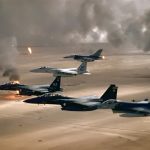
Desert Storm Lessons: What Ukraine Learns from First Gulf War

Here is a story tied to George H. W. Bush that everyone has heard of, yet in the former sovok space it barely gets attention. For us Ukrainians, however, it carries Desert Storm lessons — so it’s worth running quickly through the events of thirty years ago.
I’m talking about the First Gulf War, known as “Desert Storm.” Unlike the Second Gulf War, Desert Storm was a true blitzkrieg, although the missions and objectives differed. Still, the campaign offers several lessons we mustn’t skip if we want to avoid repeating the same mistakes.
Why Saddam Attacked Kuwait
As is often the case among the Gulf countries, the conflict started over oil. Iraq had the region’s strongest army, and Saddam Hussein felt unstoppable.
Dictators often lose touch with reality. They imagine themselves great commanders, like Napoleon. Many of them have custom uniforms made, and when things get clinical, they pose on horses for equestrian portraits. Today, Putin, Berdimuhamedow and Kim Jong Un like to show off on horseback; back then, Hussein liked to do the same.
Anyway, he got bored and decided to go to war. He picked tiny Kuwait — a country Iraq shared a land border with — and he justified the attack by accusing Kuwait of stealing oil from the Rumaila field on the border. Kuwait pumped oil on its side of the border, but Iraq insisted the whole field belonged to them.
The Invasion
On July 15, 1990 Saddam made demands against Kuwait. After various Arab and other leaders explained through diplomatic channels that he was wrong, he assured them he would not solve the dispute by force. Meanwhile, Republican Guard units — the elite of the Iraqi armed forces — were already moving toward the Kuwaiti border.
By early August he had amassed a 100,000-strong force and around two hundred tanks, and on August 2 the invasion began. Kuwait had effectively no armed forces, so the kingdom fell quickly, and the royal family evacuated to Saudi Arabia.
The UN condemned the occupation in Security Council Resolution 660. By August 7 forward elements of the US Army began arriving in Saudi Arabia to stage reception areas for the main expeditionary corps. An anti-Iraq coalition formed and eventually counted 34 countries. The coalition totaled about 670,000 personnel, of which 425,000 were American. Note: these coalitions tend to include a fairly predictable roster of states — and conspicuously exclude some who, in theory, should have been there.
On November 29, 1990, after the coalition finished assembling, the UN Security Council passed Resolution 678 — a de facto ultimatum to Saddam. It demanded Iraqi withdrawal from Kuwait by no later than January 15, 1991 (the 30th anniversary of those events is coming up). As expected, Saddam ignored the deadline.
Operation Desert Storm
On January 16, the operation known as “Desert Storm” began. Its opening phase relied entirely on combat aviation. Over the next 38 days coalition aircraft flew some 100,000 combat sorties. Heavy strategic bombers B-52 bombers struck Iraqi troops and infrastructure deep inside Iraq. These operations provide important Desert Storm lessons on coordinating air power and ground maneuvers.
Saddam decided that since the fight was on, he should lash out at Israel — a logic similar to what Iran shows today. He wanted to demonstrate leadership in the Arab world. On February 18 Iraq launched mass Scud missiles toward Israel, but the attempt had little strategic effect.
Ground Offensive
On January 29 Saddam sent two mechanized divisions and one armored division into Saudi Arabia to seize the town of Khafji. Saudi forces, aided by coalition units, repelled the attack and inflicted significant losses.
The ground phase began on February 24. The coalition signaled an amphibious assault to mislead the enemy, but the main offensive actually struck from the land border. British SAS units were among the first to enter Kuwait. Aviation and M270 MLRS pounded the enemy, while engineers used bulldozers to clear paths through the dense fortifications the Iraqis had built on the Saudi border, to let the armor through.
On February 25 a Scud rocket hit a US position in the Saudi town of Dhahran, killing 28 American service members and wounding around 100.
On February 26 Saddam ordered his forces to withdraw from Kuwait. As typical of figures like Hussein, he also ordered the destruction of Kuwait’s oil infrastructure — and crews set fire to some 700 oil wells, turning the sky black.
On February 27, the U.S. 1st Armored Division destroyed much of Iraq’s Republican Guard. On February 28 Saddam negotiated a ceasefire and the remaining Iraqi forces left. Kuwait was liberated.
Desert Storm Lessons and Conclusions
A few conclusions follow:
First – with a hostile and belligerent neighbor like Russia, it would be criminal not to belong to a defensive bloc and not to have reliable allies.
Second – even fully occupied territory can and must be liberated.
Third – ejecting an occupier effectively — in this case within about six months — requires force.
In other words, a military solution not only exists — this is one of the clearest Desert Storm lessons. Ultimatums and negotiations alone do not solve such problems.
Finally: having a weak army next to dangerous neighbors is an absolute crime that should bear the harshest consequences.
* Sovok — sarcastic abbreviation for “Soviet Union,” derived from “Sovetskiy Soyuz”. The word also means “dustpan,” carrying a double connotation of trashiness and backwardness.
Related posts:


Putin and Trump in Anchorage: The Expected Nothing
We didn’t comment at all on the substantive part of preparing the meeting between Putin and Trump in Anchorage. We only touched on some strange details and associations. [...]
Crimea Bridge Attack: Birthday Gift for Putin?
Finally — the Crimea Bridge Attack we’d been waiting for arrived. This is definitely not HIMARS firing its usual missiles. Something much more serious hit the bridge. The [...]